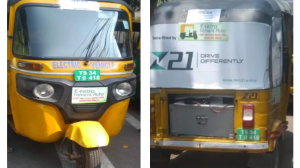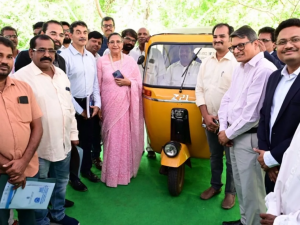New research highlights how India’s modified autonomous rickshaws can support the decarbonization of road transport and support India’s energy transition goals.
(left) a modified car from Telangana undergoing a test run in Kerala; (right) highlights the location of batteries in modified cars Credit: Natural Resources Defense Council of India
Automated rickshaws, or tricycles, are the main means of public transport in India’s small and medium-sized cities, accounting for 42-76% of public transport trips. Even in big cities, autonomous rickshaws still make up 8% of public transport. India’s huge fleet of 7.4 million passenger-carrying autonomous rickshaws is expected to grow to 11 million by 2030. However, as of 2022, the market share of electric autonomous rickshaws is still only 0.4%. Under optimal operating conditions, the auto-rickshaw industry accounts for nearly 10% of total emissions from urban road transport. By requiring new cars to be electric and retrofitting existing vehicles, the transition to electric autonomous rickshaws can help decarbonize the road transport sector and reduce urban air pollution.
Advantages and challenges of converting automatic rickshaws to electric
Retrofitting has become a viable and cost-effective solution to address the loss of efficiency and increased operating costs caused by aging vehicles, such as internal combustion engine automatic tricycles whose service life has exceeded 4-5 years. This technology effectively extends the service life of these vehicles by 5-7 years, resulting in a tangible reduction in resource consumption and carbon emissions, while significantly reducing capital expenditure by at least 50-60% compared to purchasing a new electric tricycle. In terms of material consumption, retrofitting an automatic tricycle can both recover about 220-230 kg of metal from existing internal combustion engine engines and parts, and save about 390 kg of metal needed to launch a new car. Given that around 750,000 tricycles will reach end-of-life status across the country by 2025, the nationwide retrofit programme offers a significant opportunity to recycle a large number of valuable metal resources.
The retrofit also provides a viable solution to the major challenge of limiting the range of the new electric tricycle (e-3W). By devoting a significant portion of capital expenditure to improving battery capacity, retrofitting can effectively address operational issues. This strategic approach can extend the range of the e-3W to better meet user needs. Converting a car to electric can also eliminate manual transmissions, resulting in huge health benefits for drivers.
However, there are bottlenecks. Given that modding is still in its infancy in India, there are some key barriers that deter fellow drivers from choosing modding. The lack of affordable financing options for driver partners, licensing restrictions, concerns about the difficulty of obtaining insurance, warranty and after-sales service support for modified vehicles, and inadequate charging infrastructure have hindered the development of the country’s modification industry.
New research finds a solution
Based on stakeholder consultation and new analysis, NRDC and its partners have developed a white paper that looks at the current landscape of refitted internal combustion engine vehicles in India and offers solutions to alleviate bottlenecks. The white paper, titled “Driving Progress: A Blueprint for Converting Tricycles from internal combustion Engines to electric vehicles”, was launched last week at the seminar “Advancing the Electrification of Passenger Carrying AUtorickshaws through Modification Solutions: A Blueprint for Indian Cities”, jointly organised with the Government of Telangana. The workshop was attended by senior government officials from Telangana, Karnataka, Uttar Pradesh and Kerala, as well as River Partner unions, technical service providers, financiers, fleets, CPOs and civil society organizations from the states of South India. During the event, the Government of Telangana, NRDC India and ASCI signed a tripartite Memorandum of Understanding (MOU) to advance clean mobility transformation in Telangana.
Despite pioneering conversion incentives, the penetration rate of electric vehicles in the autonomous rickshaw segment in Telangana is only 0.92 per cent. To make the retrofit ecosystem operational, NRDC and its partners have also developed a potential retrofit guide, “Power Transfer: A Framework for Retrofitting Tricycles in Telangana.” Based on research with key partners and stakeholders as well as new analysis, the framework aims to improve the adoption and effectiveness of modding in the state by providing step-by-step guidance and outlining the responsibilities of all key players. Major players have already begun to push for widespread adoption of electric vehicles in India’s autonomous rickshaw industry, including a recent commitment by the Small Industrial Development Bank of India (SIDBI), one of the country’s largest development banks, to explore financing options for converted vehicles. With momentum and continued stakeholder collaboration, further advancements will shape a cleaner, more sustainable future for urban mobility in India.
Statement: The picture and text come from the Internet, compiled and published according to public information, reproduced for the purpose of disseminating information, if there is any infringement or violation, please contact us to delete. If you need to reprint or quote the materials of this article, please indicate the source.
Post time: Jul-01-2024


